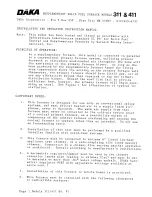
6
FIGURE 1
Checking the nozzle
The burner is equipped with an appropriate size nozzle. If another size
nozzle or a replacement is required, use the manufacturer’s nozzle
data shown in Table 2, p. 12. Note that all nozzle sizes are based on a
pump pressure of 100 psi.
Always select nozzle sizes by working back from the actual desired
flow rate at operating pressure, and not by the nozzle marking.
Checking air and turbulator settings
Before starting the burner for the first time, adjust the air and turbulator
settings to those listed in Table 2, p. 12. Once the burner becomes
operational, final adjustments will be necessary.
Checking the fuel supply system
Fuel Specifications:
NOTE: Use No.1 or No.2 Heating Oil (ASTM D396) or in Canada, use
No.1 or No.2 Furnace Oil.
Before starting the burner be sure that the fuel tank is filled with clean
oil.
WARNING
Fire and explosion hazard.
Use only approved heating type oil in this furnace.
DO NOT USE waste oil, used motor oil, gasoline or
kerosene.
Use of these will result in death, personal injury
and/or property damage.
NOTE: You may notice a slight odour the first time your furnace is
operated. This will soon disappear. It is only the oil used on certain
parts during manufacturing.
1.8)
BLOCKED VENT SHUT-OFF (BVSO
)
For chimney venting
WARNING
It is imperative that this device be installed by a
qualified agency.
This device is designed to detect the insufficient evacuation of
combustion gases in the event of a vent blockage. In such a case the
thermal switch will shut down the oil burner. The device will then need
to be re-armed MANUALLY.
Refer to the wiring diagrams and the detailed instructions supplied
with the BVSO for the installation and wiring procedures. The length of
wires supplied with the unit is such that the safety device must be
installed between the flue outlet of the appliance and the draft
regulator, as indicated in the instructions.
It is further imperative that the BVSO be maintained annually. For
more details refer to the instructions supplied with the device itself, as
well as Section 3.1.8 of this manual.
CAUTION
A positive pressure venting system (Sealed Combustion
System or Direct Vent) MUST NOT use the BVSO. Follow
the instructions supplied with the venting system.
1.9)
INSTALLING ACCESSORIES
WARNING
Electrical shock hazard.
Turn OFF electric power at the fuse box or service
panel before making any electrical connections and
ensure a proper ground connection is made before
connecting line voltage.
Failure to do so could result in property damage,
bodily injury or death.
1.9.1) Air conditioning
An air conditioning coil may be installed on the supply air side only.
Also, according to the coil manufacturer’s instructions, a minimum
clearance of 6 inches must be allowed between the bottom of the coil
drain pan, and the top of the heat exchanger. Wire the thermostat and
condensing unit contactor as indicated in the wiring diagram (Figure 4,
p. 14).
1.9.2) Ductwork and Filter
Installation
Design and install the air distribution system to comply with Air
Conditioning Contractors of America manuals or other approved
methods that conform to local codes and good trade practices.
Knockouts are provided on both sides of the furnace to cut the
required size opening for the installation of the return ductwork. This
can be done on either the right or the left side of the furnace. See
Figure 3, p. 13 for location and dimensions.
NOTE: THE BACK SHOULD NOT BE CUT OUT FOR
RETURN AIR
Provision is also made on this furnace for a bottom return air duct.
Knockouts are provided on the floor of the furnace to facilitate the
installation of the air filter rack assembly and return ductwork. (We
recommend the use of this opening for horizontal installations).
DNS-0864 Rev. A

































